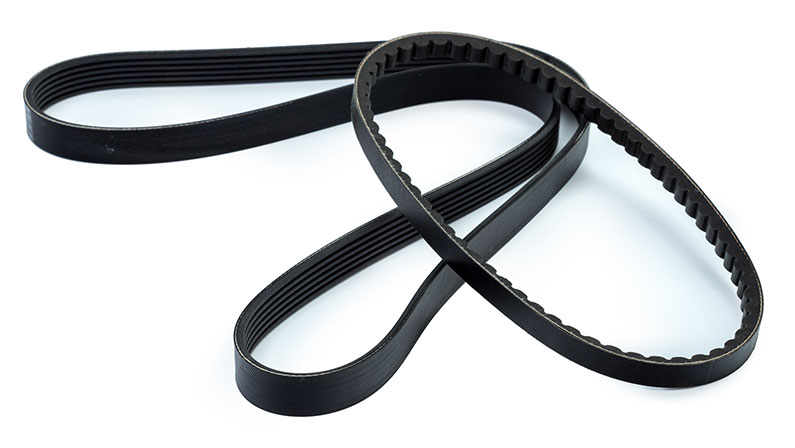The average driver doesn’t understand the difference between serpentine and timing belts for good reason. Both belts are out of sight, concealed within the engine, and out of mind. There is a common misconception that these automotive engine belts perform similar functions. Technicians and automotive enthusiasts are well aware of the fact that each belt under the hood plays a unique and important role. Let’s take a look at the specific differences between timing belts and serpentine belts.
Serpentine Belt Location and Functionality
Serpentine belts are positioned on the outside of the engine. Pop the hood and you will find a lengthy rubber band-like material stretched along the side that connects components to the engine. This is the serpentine belt. Serpentine belts typically last between 60,000 miles and 100,000 miles. However, each specific vehicle manufacturer has a specific mileage benchmark for serpentine belt replacement.
Though few know it, serpentine belts were not present in the vehicles of yesteryear. Some older cars still on the roads or in storage were designed with individual belts that correspond to each part of the vehicle that requires power. Automotive technology has progressed to the point that a continuous serpentine belt is now used instead of a series of belts for all powered components. The rubber used for today’s serpentine belts is incredibly strong, meaning it probably won’t require replacement until the vehicle is driven for five or more years.
Certain serpentine belts require manual tightening. Other vehicles have serpentine belts that are automatically tightened. Both professional and DIY (do it yourself) auto mechanics with extensive knowledge of the inner workings of engine stress, and the importance of inspecting the serpentine belt at a high frequency. If the serpentine belt has rubber that is peeling, fraying, or cracking, it should be replaced and the components around it checked for flaws. If the serpentine belt becomes shiny in appearance, additional inspection will be necessary to determine if it should be replaced.
Additional signs of a faulty serpentine belt include squealing noises, chirping noises, and electrical components that fail. The check engine light might also illuminate to indicate the serpentine belt should be inspected and possibly replaced. A serpentine belt that breaks while the vehicle is in operation is the nightmare scenario every driver should fear. All vehicle components powered by the serpentine belt will stop functioning if this important belt breaks while driving.
ACDelco Gold 6K930 Standard V-Ribbed Serpentine Belt
$34.99 (as of May 13, 2024 10:01 GMT -04:00 - More infoProduct prices and availability are accurate as of the date/time indicated and are subject to change. Any price and availability information displayed on [relevant Amazon Site(s), as applicable] at the time of purchase will apply to the purchase of this product.)ACDelco GM Original Equipment 12658178 Air Conditioning Compressor Belt Kit with Tool
$51.64 (as of May 13, 2024 10:01 GMT -04:00 - More infoProduct prices and availability are accurate as of the date/time indicated and are subject to change. Any price and availability information displayed on [relevant Amazon Site(s), as applicable] at the time of purchase will apply to the purchase of this product.)Goodyear Belts 1060480 Serpentine Belt, 6-Rib, 48" Length
$23.20 (as of May 13, 2024 10:01 GMT -04:00 - More infoProduct prices and availability are accurate as of the date/time indicated and are subject to change. Any price and availability information displayed on [relevant Amazon Site(s), as applicable] at the time of purchase will apply to the purchase of this product.)Timing Belts
Automobile engines have either a timing belt or a timing chain. Timing belts serve the purpose of spinning the alternator to convert engine power into electricity. The timing belt is also connected to the all-important power steering pump. In some engines, the timing belt connects to the water pump. The timing belt helps these components function as designed.
The timing belt links up with the crankshaft so it can connect with the engine valves to provide both fuel and air. If these connected parts are not in sync, the pistons within the engine will not fire as they should, ultimately necessitating a potentially expensive repair or replacement. Timing belts are similar to serpentine belts in that they should be replaced around the 60,000-mile mark. However, there is the potential for some timing belts to last 100,000 miles. Even those with in-depth knowledge of automobile engines sometimes take their vehicle to an experienced mechanic to have the timing belt replaced as the entire engine will have to be disassembled. If you even slightly suspect your vehicle’s timing belt is compromised, have it replaced as soon as possible as leaving the belt in position could easily sabotage the engine to the point that the car does not run.
It is also in your interest to replace the vehicle’s water pump when replacing the timing belt. The replacement of the timing belt with a new one has the potential to affect the water pump, potentially rendering it non-functional. If the vehicle in question is comparably old, the timing belt, water pump, and other related internal engine components will require replacement that much more frequently.
A timing belt that breaks while the vehicle is in operation will cause serious problems. Such a break could lead to the pistons contacting open valves which lead to significant damage. A broken timing belt is likely to damage the pistons, cylinder head, and valve, necessitating costly repairs. The worst-case scenario after a timing belt break is full engine replacement. Even if you have a thorough understanding of how timing belts work, replacing an engine on your own will be a particularly demanding DIY project.









